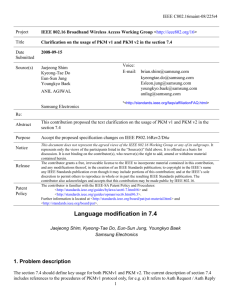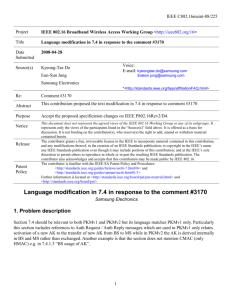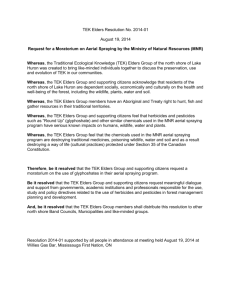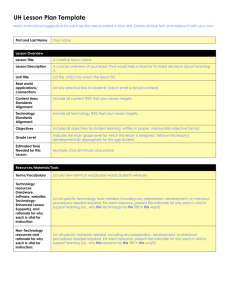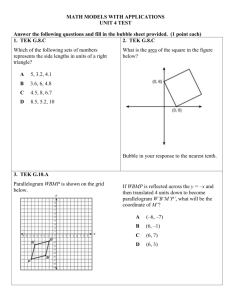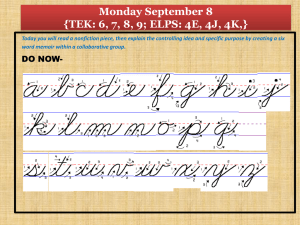Section 7.4 should be relevant to both PKMv1 and PKMv2 but its
advertisement
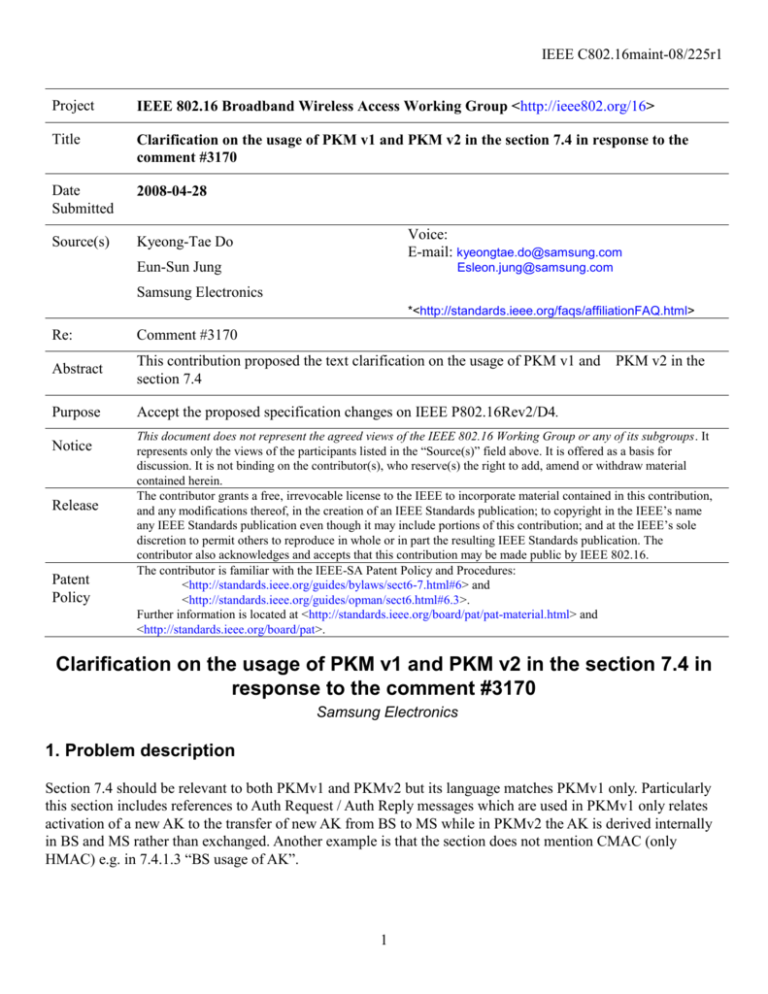
IEEE C802.16maint-08/225r1 Project IEEE 802.16 Broadband Wireless Access Working Group <http://ieee802.org/16> Title Clarification on the usage of PKM v1 and PKM v2 in the section 7.4 in response to the comment #3170 Date Submitted 2008-04-28 Source(s) Kyeong-Tae Do Voice: E-mail: kyeongtae.do@samsung.com Eun-Sun Jung Esleon.jung@samsung.com Samsung Electronics *<http://standards.ieee.org/faqs/affiliationFAQ.html> Re: Comment #3170 Abstract This contribution proposed the text clarification on the usage of PKM v1 and PKM v2 in the section 7.4 Purpose Accept the proposed specification changes on IEEE P802.16Rev2/D4. Notice Release Patent Policy This document does not represent the agreed views of the IEEE 802.16 Working Group or any of its subgroups. It represents only the views of the participants listed in the “Source(s)” field above. It is offered as a basis for discussion. It is not binding on the contributor(s), who reserve(s) the right to add, amend or withdraw material contained herein. The contributor grants a free, irrevocable license to the IEEE to incorporate material contained in this contribution, and any modifications thereof, in the creation of an IEEE Standards publication; to copyright in the IEEE’s name any IEEE Standards publication even though it may include portions of this contribution; and at the IEEE’s sole discretion to permit others to reproduce in whole or in part the resulting IEEE Standards publication. The contributor also acknowledges and accepts that this contribution may be made public by IEEE 802.16. The contributor is familiar with the IEEE-SA Patent Policy and Procedures: <http://standards.ieee.org/guides/bylaws/sect6-7.html#6> and <http://standards.ieee.org/guides/opman/sect6.html#6.3>. Further information is located at <http://standards.ieee.org/board/pat/pat-material.html> and <http://standards.ieee.org/board/pat>. Clarification on the usage of PKM v1 and PKM v2 in the section 7.4 in response to the comment #3170 Samsung Electronics 1. Problem description Section 7.4 should be relevant to both PKMv1 and PKMv2 but its language matches PKMv1 only. Particularly this section includes references to Auth Request / Auth Reply messages which are used in PKMv1 only relates activation of a new AK to the transfer of new AK from BS to MS while in PKMv2 the AK is derived internally in BS and MS rather than exchanged. Another example is that the section does not mention CMAC (only HMAC) e.g. in 7.4.1.3 “BS usage of AK”. 1 IEEE C802.16maint-08/225r1 Proposed Changes: 7.4 Key usage This section is applied to both PKMv1 and PKMv2. In this chapter, Key Request, Key Reply, Key Reject and TEK Invalid messages also indicate PKMv2 Key-Request, PKMv2 Key-Reply, PKMv2 Key-Reject and PKMv2 TEK-Invalid messages respectively unless otherwise indicated as PKMv1. 7.4.1 BS key usage The BS is responsible for maintaining keying information for all SAs. The PKM protocol defined in this specification describes a mechanism for synchronizing this keying information between a BS and its client SS. 7.4.1.1 AK key lifetime At initial network entry, after an SS completes the basic capabilities negotiation is completed to support security, the authentication shall be initiated. The AK is activated by completing authenticaton. it shall initiate an authorization exchange with its BS. The BS’s first receipt of an Auth Request message from the unauthorized SS shall initiate the activation of a new AK, which the BS sends back to the requesting SS in an Auth Reply message. This AK shall remain active until it expires according to its predefined AK Lifetime, a BS system configuration parameter. In PKMv1, tThe AK’s active lifetime a BS reports in an Authorization Reply message shall reflect, as accurately as an implementation permits, the remaining lifetimes of AK at the time the Authorization Reply message is sent. In PKMv2, AK lifetime is decided by either PMK lifetime or PAK lifetime or both. And, the AK is activated by the completion of SA-TEK 3-way handshake. The old AK can be used before the frame number specified in PKMv2 SA-TEK-Response message. If an SS fails to reauthorize before the expiration of its current AK, the BS shall hold no active AKs for the SS and shall consider the SS unauthorized. A BS shall remove from its keying tables all TEKs associated with an unauthorized SS’s Primary SA. 7.4.1.2 AK transition period on BS side The BS shall always be prepared to start re-authenticaitonsend an AK to an SS upon request. The BS shall be able to support two simultaneously active AKs for each client SS. The BS has two active AKs during an AK transition period; the two active keys have overlapping lifetimes. In PKMv1, aAn AK transition period begins when the BS receives an Auth Request message from an SS and the BS has a single active AK for that SS. In response to this Auth Request, the BS activates a second AK [see point (a) and (d) in Figure 168], which shall have a key sequence number one greater (modulo 16) than that of the existing AK and shall be sent back to the requesting SS in an Auth Reply message. The BS shall set the active lifetime of this second AK to be the remaining lifetime of the first AK [between points (a) and (c) in Figure 168], plus the predefined AK Lifetime; thus, the second, “newer” key shall remain active for one AK Lifetime beyond the expiration of the first, “older” key. The key transition period shall end with the expiration of the older key. This is depicted on the right-hand side of Figure 168. As long as the BS is in the midst of an SS’s AK transition period, and thus is holding two active AKs for that SS, it shall respond to Auth Request messages with the newer of the two active keys. Once the older key expires, an Auth Request shall trigger the activation of a new AK, and the start of a new key transition period In PKMv2, the new AK is activated by completing SA-TEK 3-way handshake. The old AK should be maintained until the frame number specified in PKMv2 SA-TEK-Response message. The key sequence number of the new AK is incremented (modulo 16) by the rule shown in Table 202. The rule to decide the AK lifetime is also shown in Table 202. 7.4.1.3 BS usage of AK The BS shall use keying material derived from the SS’s AK for the following: 2 IEEE C802.16maint-08/225r1 a) Verifying the C/HMAC-Digests in Key Request messages received from that SS, b) Calculating the C/HMAC-Digests it writes into Key Reply, Key Reject, and TEK Invalid messages sent to that SS, and c) Encrypting the TEK in the Key Reply messages it sends to that SS. A BS shall use an C/HMAC_KEY_U (see 7.5.4.3 and 7.5.4.4) derived from one of the SS’s active AKs to verify the C/HMAC-Digest in Key Request messages received from the SS. The AK Key Sequence Number accompanying each Key Request message allows the BS to determine which C/HMAC_KEY_U was used to authenticate the message. If the AK Key Sequence Number indicates the newer of the two AKs, the BS shall identify this as an implicit acknowledgment that the SS has obtained the newer of the SS’s two active AKs [see points (b) in Figure 168 for PKMv1]. A BS shall use an C/HMAC_KEY_D derived from the active AK selected above (see also 7.5.4.3 and 7.5.4.4) when calculating C/HMAC-Digests in Key Reply, Key Reject, and TEK Invalid message. When sending Key Reply, Key Reject, or TEK Invalid messages within a key transition period (i.e., when two active AKs are available), if the newer key has been implicitly acknowledged, the BS shall use the newer of the two active AKs. If the newer key has not been implicitly acknowledged, the BS shall use the older of the two active AKs to derive the KEK and the C/HMAC_KEY_D. The BS shall use a KEK derived from an active AK when encrypting the TEK in the Key Reply messages. The right-hand side of Figure 168 illustrates the BS’s policy regarding its use of AKs in PKMv1, where the shaded portion of an AK’s lifetime indicates the time period during which that AK shall be used to derive the HMAC_KEY_U, HMAC_KEY_D, and KEK. For calculating the C/HMAC-Digest in the C/HMAC Tuple attribute, the BS shall use the C/HMAC_KEY_U and C/HMAC_KEY_D derived from one of the active AKs. For signing messages, if the newer AK has been implicitly acknowledged, the BS shall use the newer of the two active AKs to derive the C/HMAC_KEY_D. If the newer key has not been implicitly acknowledged, the BS shall use the older of the two active AKs to derive the C/HMAC_KEY_D. The C/HMAC Key Sequence Number in the C/HMAC Tuple, equal to the AK’s sequence number from which the C/HMAC_KEY_D was derived, enables the SS to correctly determine which C/HMAC_KEY_D was used for message authentication. When receiving messages containing the C/HMAC Tuple attribute, the BS shall use the C/HMAC_KEY_U indicated by the C/HMAC Key Sequence Number to authenticate the messages. 7.4.1.4 TEK lifetime The BS shall maintain two sets of active TEKs (and their associated Initialization Vectors, or IVs) per SAID, corresponding to two successive generations of keying material. The two generations of TEKs shall have overlapping lifetimes determined by TEK Lifetime, a predefined BS system configuration parameter. The newer TEK shall have a key sequence number one greater (modulo 4) than that of the older TEK. Each TEK becomes active halfway through the lifetime of its predecessor and expires halfway through the lifetime of its successor. Once a TEK’s lifetime expires, the TEK becomes inactive and shall no longer be used. The Key Reply messages sent by a BS contain TEK parameters for the two active TEKs. The TEKs’ active lifetimes a BS reports in a Key Reply message shall reflect, as accurately as an implementation permits, the remaining lifetimes of these TEKs at the time the Key Reply message is sent. 7.4.1.5 BS usage of TEK The BS transitions between the two active TEKs differently, depending on whether the TEK is used for DL or UL traffic. For each of its SAIDs, the BS shall transition between active TEKs according to the following rules: a) At expiration of the older TEK, the BS shall immediately transition to using the newer TEK for encryption. b) The UL transition period begins from the time the BS sends the newer TEK in a Key Reply message and concludes once the older TEK expires. It is the responsibility of the SS to update its keys in a timely fashion; the BS shall transition to a new DL encryption key regardless of whether a client SS has retrieved a copy of that TEK. The BS uses the two active TEKs differently, depending on whether the TEK is used for DL or UL traffic. For each of its SAIDs, the BS shall use the two active TEKs according to the following rules: a) The BS shall use the older of the two active TEKs for encrypting DL traffic. b) The BS shall be able to decrypt UL traffic using either the older or newer TEK. Note that the BS encrypts with a given TEK for only the second half of that TEK’s total lifetime. The BS is able, however, to decrypt 3 IEEE C802.16maint-08/225r1 with a TEK for the TEK’s entire lifetime. The right-hand side of Figure 169 illustrates the BS’s management of an SA’s TEKs, where the shaded portion of a TEK’s lifetime indicates the time period during which that TEK shall be used to encrypt MAC PDU payloads. 7.4.2 SS key usage In PKMv1, tThe SS is responsible for sustaining authorization with its BS and maintaining an active AK. In PKMv2, reauthentication can be triggered by either BS or MS. An SS shall be prepared to use its two most recently obtained AKs according to the manner described in 7.4.2.1 through 7.4.2.3. 7.4.2.1 SS reauthenticationreauthorization AKs have a limited lifetime and shall be periodically refreshed. In PKMv1, aAn SS refreshes its AK by reissuing an Auth Request to the BS. The Authorization State Machine (7.2.1.5) manages the scheduling of Auth Requests for refreshing AKs. In PKMv2, both SS and BS can refresh their AK. An SS can trigger reauthentication by issuing PKMv2 EAP-Start message and the BS by PKMv2 EAPTransfer message. The authentication state machine for PKMv2 is decribed in 7.2.2.5 In PKMv1, aAn SS’s Authorization state machine schedules the beginning of reauthorization a configurable duration of time, the Authorization Grace Time, [see points (x) and (y) in Figure 168], before the SS’s latest AK is scheduled to expire. The Authorization Grace Time is configured to provide an SS with an authorization retry period that is sufficiently long to allow for system delays and provide adequate time for the SS to successfully complete an Authorization exchange before the expiration of its most current AK. In PKMv2, reauthentication can be triggered when Authorization Grace Timer expires, CMAC_KEY_COUNT or CMAC_PN_* approaches the maximum number, or PKMv2 EAP-Transfer message is sent by the BS. Note that the BS does not require knowledge of the Authorization Grace Time. The BS, however, shall track the lifetimes of its AKs and shall deactivate a key once it has expired. 7.4.2.2 SS usage of AK An SS shall use the C/HMAC_KEY_U derived from the newer of its two most recent AKs when calculating the C/HMAC-Digests it attaches to Key Request messages. The SS shall be able to use the C/HMAC_KEY_D derived from either of its two most recent AKs to authenticate Key Reply, Key Reject, and TEK InvalidReject messages. The SS shall be able to decrypt an encrypted TEK in a Key Reply message with the KEK derived from either of its two most recent AKs. The SS shall use the accompanying AK Key Sequence Number to determine which set of keying material to use. The left-hand side of Figure 168 illustrates an SS’s maintenance and usage of its AKs in PKMv1, where the shaded portion of an AK’s lifetime indicates the time period during which that AK shall be used to decrypt TEKs. Even though it is not part of the message exchange, Figure 168 also shows the implicit acknowledgment of the reception of a new AK via the transmission of a Key Request message using the key sequence of the new AK. An SS shall use the C/HMAC_KEY_U derived from the newer of its two most recent AKs when calculating the C/HMAC-Digests of the C/HMAC Tuple attribute. 7.4.2.3 SS usage of TEK An SS shall be capable of maintaining two successive sets of traffic keying material per authorized SAID. Through operation of its TEK state machines, an SS shall request a new set of traffic keying material a configurable amount of time, the TEK Grace Time [see points (x) and (y) in Figure 169], before the SS’s latest TEK is scheduled to expire. For each of its authorized SAIDs, the SS — Shall use the newer of its two TEKs to encrypt UL traffic, and — Shall be able to decrypt DL traffic encrypted with either of the TEKs. 4 IEEE C802.16maint-08/225r1 The left-hand side of Figure 169 illustrates the SS’s maintenance and usage of an SA’s TEKs, where the shaded portion of a TEK’s lifetime indicates the time period during which that TEK shall be used to encrypt MAC PDU payloads. References [IEEE802.16-Rev2/D4] IEEE Computer Society and IEEE Microwave Theory and Techniques Society, “DRAFT Standard for Local and Metropolitan Area Networks Part 16: Air Interface for Broadband Wireless Access Systems”, P802.16Rev2/D4 (April 2008) (Revision of IEEE Std 802.16-2004 and consolidates material from IEEE Std 802.16e-2005, IEEE Std 802.16-2004/Cor1-2005, IEEE Std 802.16f-2005 and IEEE Std802.16g-2007) 5

